Proper nutrition is critical for layer chickens to ensure optimal egg production and health. A well-structured feeding guide helps in managing dietary needs across different growth stages effectively and efficiently.
- Provides essential nutrients for growth and egg production.
- Includes phased feeding plans for chicks‚ pullets‚ and laying hens.
- Ensures balanced nutrition for sustained productivity and health.
Importance of Proper Nutrition for Layer Chickens
Proper nutrition is essential for layer chickens to maintain health‚ productivity‚ and egg quality. A balanced diet ensures optimal growth‚ prevents health issues‚ and supports robust egg production. Layer chickens require specific nutrients like protein‚ calcium‚ and vitamins to produce strong eggshells and maintain laying capacity; Poor nutrition can lead to reduced egg output‚ weaker shells‚ and increased mortality rates. Adequate feeding also influences egg size‚ mass‚ and overall flock performance. A well-formulated diet tailored to their life stage ensures layer chickens meet their genetic potential‚ making nutrition a cornerstone of successful poultry management. Proper feeding practices also reduce waste and costs‚ contributing to a sustainable and efficient egg production system.
Layer Chicken Feeding Program
A structured feeding program for layer chickens includes three phases: starter‚ grower‚ and layer diets‚ each tailored to meet nutritional needs at different growth stages for optimal health and productivity.
Phase 1: Chick Starter Diet (0-6 Weeks)
The chick starter diet is crucial for the first six weeks of a layer chicken’s life. This phase focuses on providing a high-protein diet‚ typically between 20-24% protein‚ to support rapid growth and development. The starter feed is usually in mash form to ensure easy digestion for young chicks. It’s essential to include essential nutrients like calcium and phosphorus for bone development and vitamins for overall health. Overfeeding should be avoided to prevent health issues. Chicks should have access to feed at all times during this period‚ and the feed should be placed in shallow pans or paper to encourage eating; Transitioning to a grower diet after six weeks ensures a smooth progression in their nutritional needs. Proper management of this phase sets the foundation for healthy growth and future egg production.
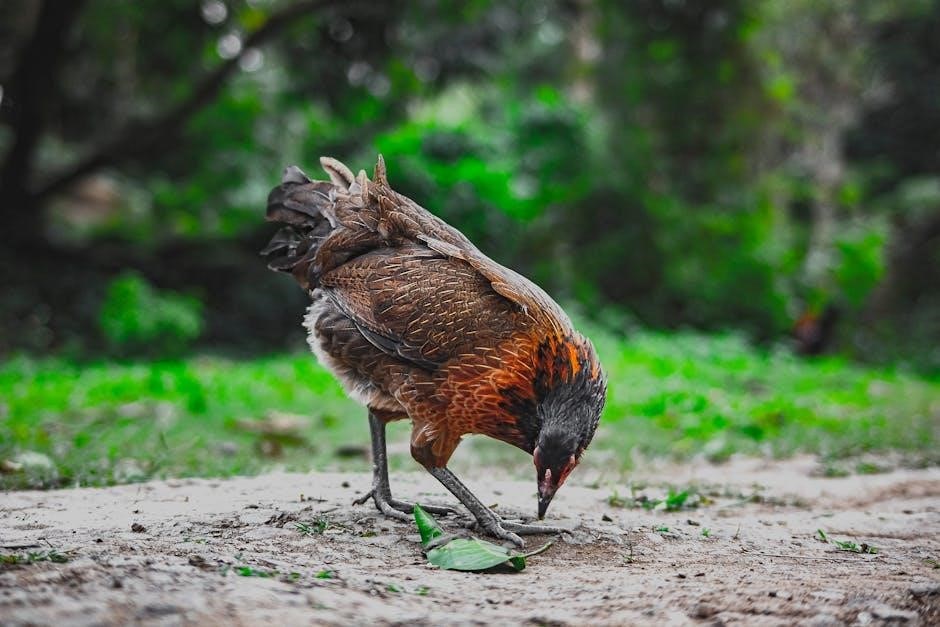
Phase 2: Grower Diet (7-18 Weeks)
The grower diet is introduced from 7 to 18 weeks of age‚ focusing on supporting the pullet’s growth and development. This phase transitions the chicks from the high-protein starter diet to a slightly lower protein content‚ typically around 16-18%. The grower feed is formulated to promote healthy growth while preventing excessive weight gain. It is usually provided in mash or pellet form‚ depending on the flock’s needs. Essential nutrients like calcium‚ phosphorus‚ and vitamins are included to support bone development and overall health. During this phase‚ it’s important to avoid overfeeding to prevent obesity‚ which can negatively impact future egg production. Access to fresh water should always be available to ensure proper digestion and hydration. This phase lays the groundwork for the transition to the layer diet‚ ensuring the pullets are well-prepared for egg production.
Phase 3: Layer Diet (18 Weeks and Above)
At 18 weeks and above‚ hens transition to the layer diet‚ specifically formulated to support egg production. This diet is richer in calcium to strengthen eggshells and typically contains 16-18% protein to sustain productivity. Energy levels are adjusted to meet the metabolic demands of laying eggs. Layer feed is usually provided in pellet or mash form‚ ensuring ease of digestion and nutrient absorption. Access to grit is recommended to aid in breaking down feed. Monitoring feed intake is crucial‚ as overfeeding can lead to waste and health issues. Fresh water should always be available to maintain hydration and overall health. This phase focuses on maintaining consistent egg production and ensuring the hens remain healthy and productive throughout their laying cycle.
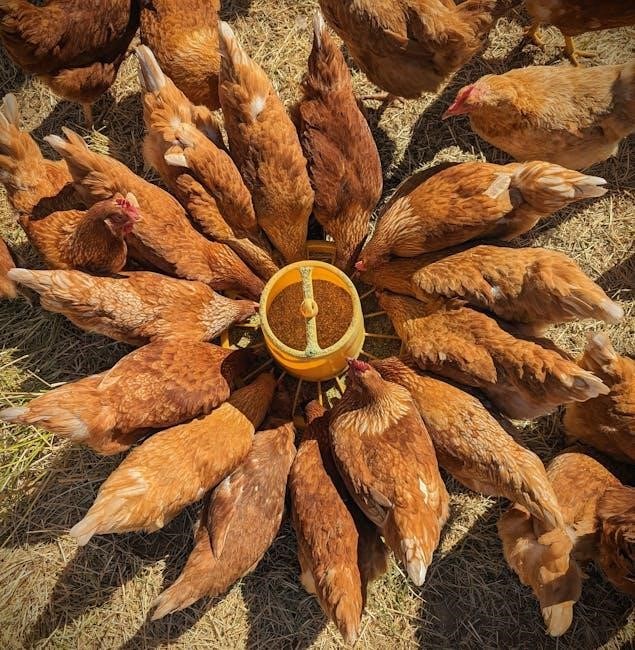
Types of Layer Chicken Feed
Layer chicken feed types include starter‚ grower‚ and layer diets‚ each formulated for specific growth stages to optimize health and productivity‚ with options like pellets or mash for ease of consumption.
Starter Feed for Chicks
Starter feed is specifically formulated for chicks from 0 to 6 weeks of age‚ providing essential nutrients for rapid growth and development. High in protein (20-24%)‚ it supports muscle and feather development. The feed is usually offered as a fine mash or crumb to ensure easy consumption. During this stage‚ chicks require frequent feeding to meet their high energy demands. Proper starter feed ensures strong immune systems and a healthy foundation for future productivity. Farmers often use pan feeders or paper to dispense starter feed‚ transitioning to troughs as chicks grow. Fresh water must always accompany starter feed to promote digestion and overall health. A well-balanced starter diet is crucial for maximizing growth rates and minimizing health issues in young layer chickens.
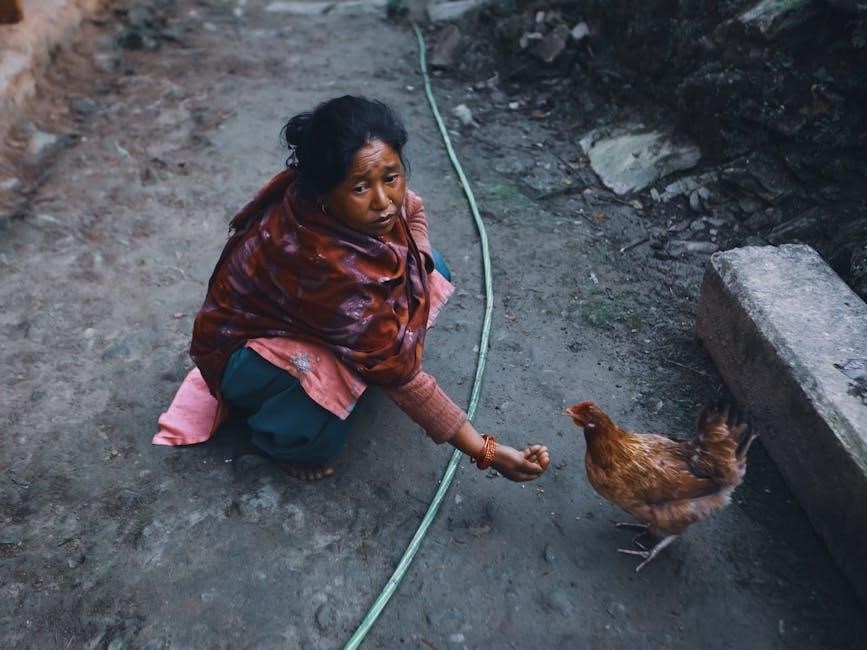
Grower Feed for Pullets
Grower feed is formulated for pullets during the 7- to 18-week stage‚ focusing on continued growth and development before laying begins. It typically contains 16-18% protein‚ slightly lower than starter feed‚ to support frame development and feather growth. This phase transitions pullets toward the nutritional requirements of laying hens. Grower feed is often provided as mash or pellets‚ ensuring ease of consumption. Farmers should introduce layer feed gradually during the final weeks of this stage to prepare pullets for egg production. Proper grower feed supports healthy bone development and energy reserves‚ ensuring pullets reach optimal body weight and condition. Balanced nutrients‚ including calcium and vitamins‚ are critical during this phase to promote long-term productivity and health.
Layer Feed for Egg Production
Layer feed is specifically designed for hens in production‚ typically from 18 weeks onward‚ to support egg laying and overall health. It contains 16-18% protein and higher calcium levels to strengthen eggshells. Energy content is optimized to balance the demands of egg production and body maintenance. Layer feed is available as mash or pellets‚ with pellets often reducing waste. Farmers should ensure hens have constant access to layer feed‚ as egg production directly depends on their dietary intake. Proper layer feed formulation promotes consistent egg size‚ shell quality‚ and yolk color. Adequate nutrition during this phase is crucial for sustaining productivity and preventing health issues. Regular monitoring of feed intake and egg output helps maintain optimal performance in layer hens.
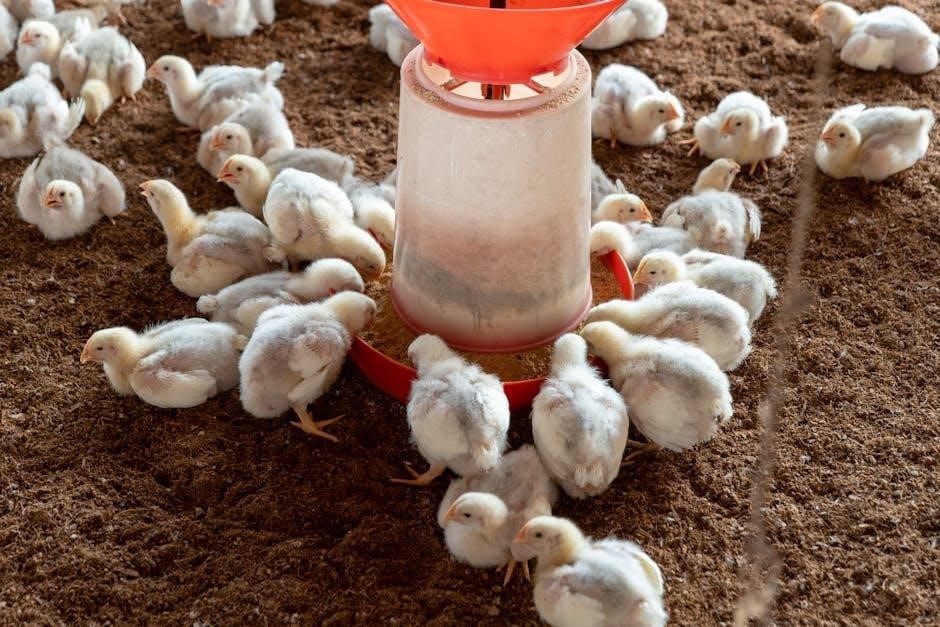
Feeding Equipment and Management

Proper feeding equipment ensures efficient feed distribution and minimizes waste. Plastic feeders are durable and adjustable‚ while troughs and pans are suitable for chicks. Regular cleaning and maintenance are essential.
- Choose feeders that hold a day’s worth of feed.
- Adjust feeders to prevent spillage and waste.
- Ensure easy access for all birds to promote even feeding.
Recommended Feeders for Layer Chickens
Plastic feeders are highly recommended for layer chickens due to their durability and ease of cleaning. They are adjustable to prevent overfilling and reduce feed waste. Trough-style feeders are also effective‚ providing easy access for multiple birds. For chicks‚ pan feeders or paper-based feeding systems are ideal during the first few weeks. As the flock grows‚ transitioning to hanging feeders or automated systems can improve efficiency. Regardless of the feeder type‚ ensuring it holds no more than a day’s worth of feed helps maintain freshness and reduces contamination. Regular cleaning and maintenance of feeding equipment are crucial to prevent mold and bacterial growth‚ ensuring the health and productivity of the flock. Proper feeder placement and accessibility are also key to promoting even feeding and reducing stress among the birds.
Best Practices for Feeding Layer Hens
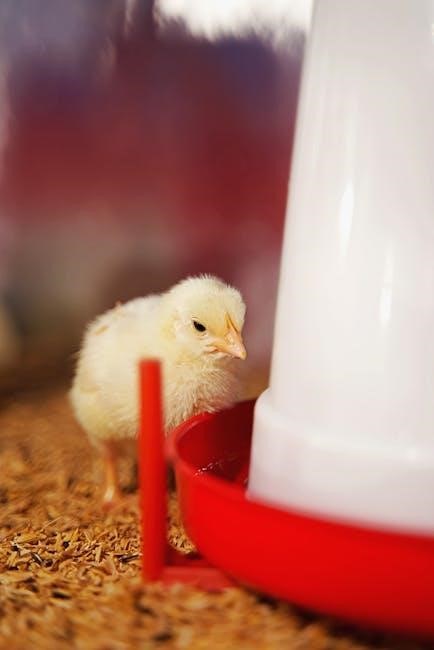
Feeding layer hens requires a consistent and well-planned approach to ensure maximum productivity and health. Provide high-quality layer feed with 16-18% protein and adequate calcium for strong eggshell production. Restrict feeding during the rearing phase to avoid overfeeding‚ but ensure unrestricted access once laying begins. Use skip-a-day feeding regimens if necessary‚ but avoid restricting feed near the point of lay. Adjust feeders to prevent overcrowding and waste‚ ensuring all birds can eat comfortably. Offer fresh water at all times‚ and monitor feed intake to avoid overfeeding‚ which can lead to health issues. Regularly clean feeding equipment to prevent mold and bacterial growth. Observe your flock’s behavior to ensure all hens are eating well and adjust feeding strategies as needed; Consulting a layer feeding guide can help tailor these practices to your flock’s specific needs for optimal egg production and health.